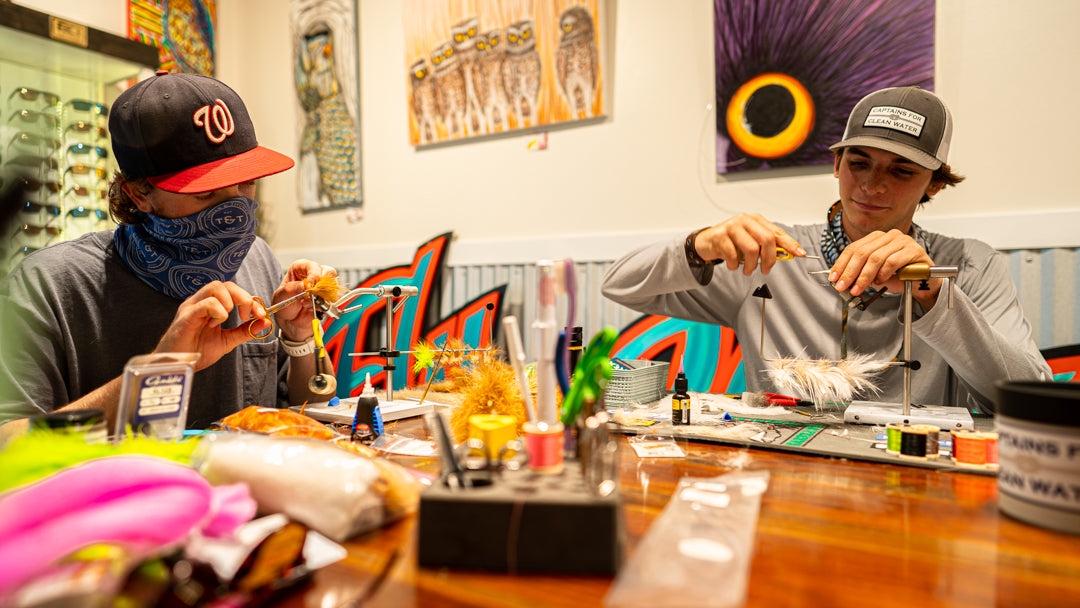
A lot of commercial saltwater fly tying is done by people who do not live anywhere near tropical flats, or any ocean, which can be problematic when they are trying to sell you flies, gear, line, or any other piece of gear engineered and designed for saltwater flats.


The Abaco Shrimp, as pictured above, is a pattern I have been working on for several months now. Although the fly works, there are instances where it could work better, thus my constant process of developing new flies! Guiding and photograph by Kenny Adkisson of Summerland Key.
I am inherently suspicious of fly tyers who do not tie the flies that they intend to fish. Like the old adage, “practice what you preach” there is little that irks me more than someone hawking bonefish flies who has not spent days and days, or even years of their life tracking the tendencies of bonefish and how and what they eat.
The state of modern fly tying is great, because there are a lot of people doing it. And that is exactly what should be happening. After all, for the sake of transparency, I work at a fly shop that sells flies, and fly tying material - this makes me excited that people are interested in getting into the hobby, sport, lifestyle - whatever you want to call fly fishing and fly tying.

I run through this list of things when I sit down to tie, as I have a very analytical brain when it comes to fishing. I overthink, and sometimes to my detriment. But I am here to shed some thoughts on folks who sometimes get stuck at the vise, or are unsure of what to do. Here are a few ways that I accomplish my goals with designing flies.
Tie The Same Thing!

Tying the same fly over and over and over again will prove a few things to you. Of the things revealed about this exercise, I usually come across two main points.
- What is not needed has to go.
- What I need to work on is apparent.
Regarding the first point: the extraneous parts of my fly will become brutally apparent, and I will either forget to tie them in as I tie the fly more and more, or I will reconsider them and see them as out of place. A natural erosion of materials will show you exactly what you need and what is superfluous. Like cooking a great meal, you learn over time what is extra and what is essential by the way it tastes. As you tie, and fish, the same fly over and over, you will see (if you are paying attention) what needs to go and what needs to stay.
The second point: if my technique is poor, like working with a specific material or a style of tying, all the flies I tie in one sitting will look inconsistent. Facts are hard to ignore, and if all twelve flies have a different bad hair day, maybe its worth taking a second look!
Here’s a bit of an example for you; I’m terrible at tying EP Fiber style baitfish. They are my nemesis (sorry EP!), and I definitely shy away from tying them because they are a weak point in my game (like a point guard who doesn’t have a left hand dribble). If I were to really sit down and tie twelve baitfish, I would be able to see that all twelve would look different. Different proportions, different lengths, and eventually different weights. Different flies = an inconsistent fly tyer. To the recreational and quick tyer who does not care what their flies look like, this is totally fine! Now you have twelve new flies and less blank space in your fly box. However, I want to make consistent flies that I can tie and give customers in the shop to go out and fish, so I need to make sure they are my best work. Leaning into your weaknesses will make you a much more developed, experienced, and well rounded fly tyer. Now to tackle those baitfish...
Fish The Fly!

How often have you seen a fly do exactly what you want it to do, the first time it hits the water? For me, it has never happened, if I am employing a newly developed pattern, or a spin off of a proven one. If you tie flies that are already proven, then this won’t be the case, as they have already been through the drafting process and are fully developed objects in the world of fishing.
However, if you are playing around with new materials, techniques, and styles, you will find out quickly that a lot of it does not work together. Tying flies is about the fun of what happens when you take 9 failures and contrast them to the one successful shot at making something new. This is the excitement - the process as it relates to the finished product, not the other way around.
So enjoy that process! Test the fly, fish the fly, and if you don’t have the time to fish, give it to a friend or a stranger who does! In the age of social media, getting a hold of people and picking their brain is easier than ever, so don’t be shy! Just make sure the fly gets in the water, in front of a fish!
The real test of “if the fly swims” is swimming it in front of your target species, and then seeing if they eat it. Really, what I’m trying to say is do your homework. And if you can’t, or don’t do the homework, just tie for the sake of tying - because you love it and can’t see yourself doing anything else. I am under the impression that fly tying goes hand in hand with fly fishing, so create goals for yourself on the tying bench and see if you can reach them on the water.
Low Expectations

The Clouser Minnow has already been invented, so do not expect that whatever you fire off the vise will be the next best thing. Low expectations for your inventions will allow you the space to fail gracefully, which is an inherent happening in the drafting process of fly design. If you did not fail in order to get there, you didn’t do anything new, different, or innovative.
Sometimes, in my own fly tying, I question whether I have done anything new, or if there is anything new left. Obviously, this is an existential rabbit hole that we can all go down and get lost in quickly. But do not let your fear of failure stop you from exploring your creativity, new waters, new species, or new techniques.
Most flies take years to develop, and you shouldn’t be ashamed if you don’t get it right on the first try, the second try, or even the third. Try ten, fifty, three hundred attempts and drafts! We are always growing, exploring, and curious about the endless possibilities that lie before us in the fly tying world.


0 comments